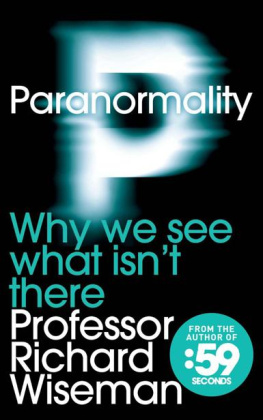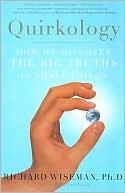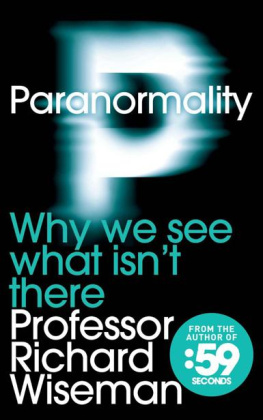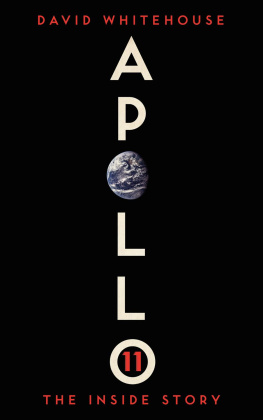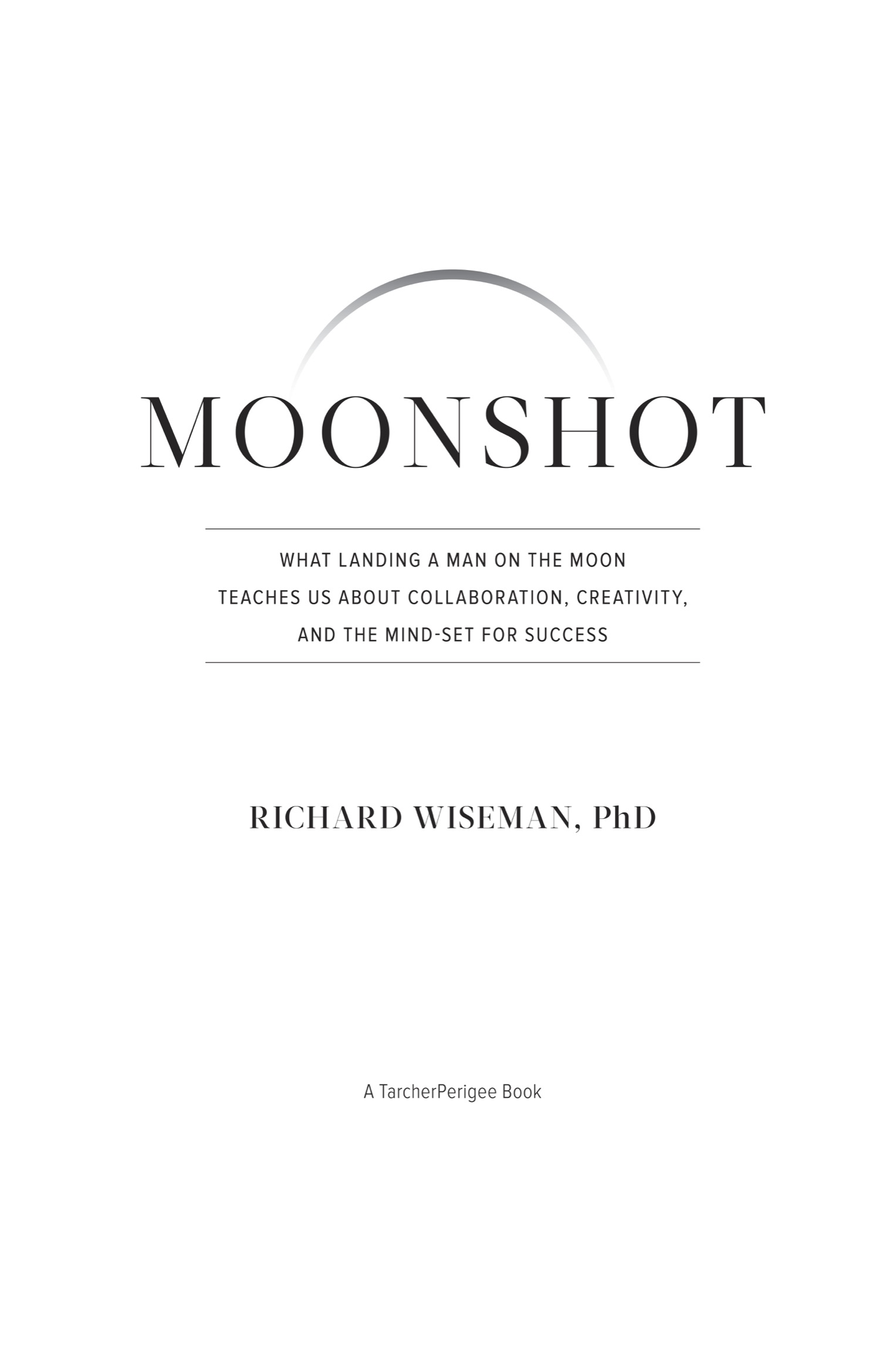
An imprint of Penguin Random House LLC
penguinrandomhouse.com
Copyright 2019 by Richard Wiseman
Previously published in Great Britain in 2019 by Quercus Editions Ltd, an Hachette UK company
Penguin supports copyright. Copyright fuels creativity, encourages diverse voices, promotes free speech, and creates a vibrant culture. Thank you for buying an authorized edition of this book and for complying with copyright laws by not reproducing, scanning, or distributing any part of it in any form without permission. You are supporting writers and allowing Penguin to continue to publish books for every reader.
TarcherPerigee with tp colophon is a registered trademark of Penguin Random House LLC.
Library of Congress Cataloging-in-Publication Data
Names: Wiseman, Richard (Richard John), author.
Title: Moonshot : what landing a man on the moon teaches us about collaboration, creativity, and the mindset for success / Professor Richard Wiseman.
Description: New York : TarcherPerigee, 2019. | Includes bibliographical references and index.
Identifiers: LCCN 2018057941 | ISBN 9780525538370 (hardback) | ISBN 9780525538394 (ebook)
Subjects: LCSH: Self-actualization (Psychology). | Creative ability. | Motivation (Psychology). | Leadership. | BISAC: BUSINESS & ECONOMICS / Motivational. | SELF-HELP / Personal Growth / Success. | BUSINESS & ECONOMICS / Leadership.
Classification: LCC BF637.S4 W647 2019 | DDC 158.1dc23
LC record available at https://lccn.loc.gov/2018057941
Neither the publisher nor the author is engaged in rendering professional advice or services to the individual reader. The ideas, procedures, and suggestions contained in this book are not intended as a substitute for consulting with your physician. All matters regarding your health require medical supervision. Neither the author nor the publisher shall be liable or responsible for any loss or damage allegedly arising from any information or suggestion in this book.
Version_2
We choose to go to the Moon in this decade and do the other things, not because they are easy, but because they are hard, because that goal will serve to organize and measure the best of our energies and skills, because that challenge is one that we are willing to accept, one we are unwilling to postpone, and one which we intend to win.
President John F. Kennedy, September 1962
Contents
Where we discover how an entire nation fell in love with a mission to the Moon, and find out how you can harness the power of passion
Where we meet the innovative engineer who saved the day with a brilliant mission plan, and find out how you can create ideas that are out of this world
Where we encounter the brilliant leader that put his faith in a group of young people, and discover how you can reap the rewards of self-belief
Where we learn about the tragic fire that forced everyone to pull up and take stock, and find out how you can learn from failure
Where we come across the mantra that ensured the worlds largest rocket got off the ground, and uncover how you can develop the attitude that gives you altitude
Where we venture into the unknown with the first manned mission to the Moon, and learn how you can find the courage to stop talking and start doing
Where we learn how quick thinking saved the historic Moon landings with just seconds to spare, and find out how you can prepare for almost every eventuality
Where we discover how astronauts had to improvise their way home, and learn how you can thrive in the face of the unexpected
Timeline
OCTOBER 1957 : Soviets launch Sputnik.
NOVEMBER 1957 : Sputnik 2 sends Laika the dog into space.
APRIL 1961 : Russian cosmonaut Yuri Gagarin orbits the Earth.
MAY 1961 : Alan Shepard becomes the first American in space.
MAY 1961 : President John F. Kennedy announces to Congress that America will put a man on the Moon before the decade is out.
SEPTEMBER 1962 : Kennedy delivers his We choose to go to the Moon speech at Rice University.
JANUARY 1967 : Tragic Apollo1 fire results in the death of three astronauts.
DECEMBER 1968 : Apollo8 becomes the first manned mission to the Moon.
JULY 16, 1969 : Apollo 11 astronauts Neil Armstrong, Buzz Aldrin, and Michael Collins begin their historic journey to the Moon.
JULY 21, 1969 : Armstrong sets foot on the lunar surface, declaring: Thats one small step for a man, one giant leap for mankind.
JULY 24, 1969 : Apollo 11 splashes down safely in the Pacific Ocean and fulfills Kennedys astonishing aim of having a man walk on the lunar surface, and return safely to the Earth, before the end of the decade.
Liftoff
Open almost any book about how to achieve your aims and ambitions and you will quickly encounter stories of genetically gifted Olympians, hardheaded CEOs, and risk-taking entrepreneurs. This book presents a radically different perspective on success. Its based around a group of young and surprisingly ordinary people. Their inspirational story is little known and yet they played a central role in humanitys greatest achievement. Perhaps most important of all, once you understand how they did what they did, you can follow in their footsteps and achieve the extraordinary in your own life.
As a psychologist, I have spent much of my career examining why some people and organizations are especially successful. A few years ago, I became interested in the Moon landings, and was astonished to discover that although the technology used during the missions has been extremely well documented, very little has been written about the psychology that lies behind this remarkable achievement. As I started to dig deeper, I encountered several other big surprises.
On July 21, 1969, Apollo astronaut Neil Armstrong gently set foot on the powdery surface of the Moon. Live images of this historic event were beamed back to the Earth, where over 500 million people watched in wonder. Just eight years before, President John F. Kennedy had appeared in front of Congress and famously declared that before the decade was out, America would put a man on the Moon. Looking back, its hard to fully appreciate the enormity of the goal.
When the president made his historic announcement, America had only managed to send one astronaut on a fifteen-minute, up-and-down suborbital flight. Kennedys bold vision required several astronauts to journey over 236,000 miles across space, land on a distant and hostile world, and safely make their way back home. Even modern-day space travel pales in comparison, with the space shuttle and International Space Station only traveling around 230 miles above the surface of the Earth. Moreover, Kennedys goal had to be achieved within a few years, and at a time when the latest cutting-edge technology consisted of slide rules and mainframe computers with less processing power than a modern-day smartphone.
To many, Kennedys dream appeared to be truly impossible. Nevertheless, hundreds of thousands of people came together and attempted to transform that dream into reality. They invented new forms of technology, overcame setbacks and tragedies, and built spacecraft containing millions of bespoke parts. Against astonishing odds, the Moon landings were a spectacular success and provided the world with an unparalleled sense of optimism and hope.


